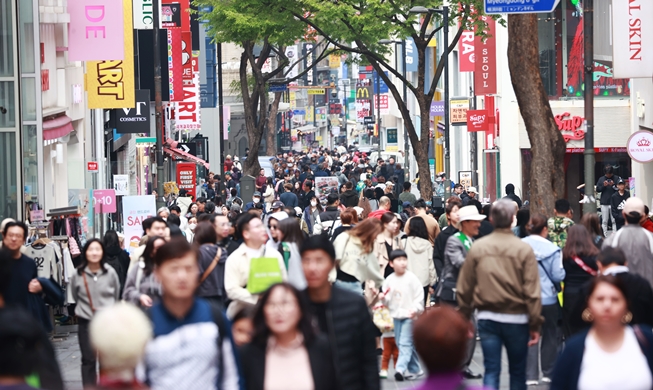-
 Korea.net's 24-hour YouTube channel
Korea.net's 24-hour YouTube channel- NEWS FOCUS
- ABOUT KOREA
- EVENTS
- RESOURCES
- GOVERNMENT
- ABOUT US
- 한국어
- English
- 日本語
- 中文
- العربية
- Español
- Français
- Deutsch
- Pусский
- Tiếng Việt
- Indonesian
In the early days of the 1950s and 1960s, there was a plethora of U.S. military stationed across Korea and a dearth of harvestable grain, food distribution networks or luxury meals. The desperation and poverty, and man's ever-blossoming inventiveness when it comes to food and making the best of a bad situation, led to the creation of one of modern Korean cuisine's most quintessentially "this could only have been invented in Korea" dishes. Man has to eat, there wasn't much around, and this one dish embodies the moguls traversed by modern Korea, through independence, through the Korean War (1950-1953), through authoritarianism, through the U.S. military presence and through the male population's experience of mandatory military duty.
The main ingredients that eventually found their way into this dish were commonly found in the rations endured by the U.S. Army. Crack open a can of Spam and slice it up, and open a can of baked beans. Dump them both into some boiling water with red pepper paste (고추장) and kimchi (김치). Believed to have originated in Uijeongbu (의정부), a district of military bases north of Seoul, thus is born modern Korean cuisine's fundamental fusion food, literally called army base stew, or budae jjigae (부대 찌개).
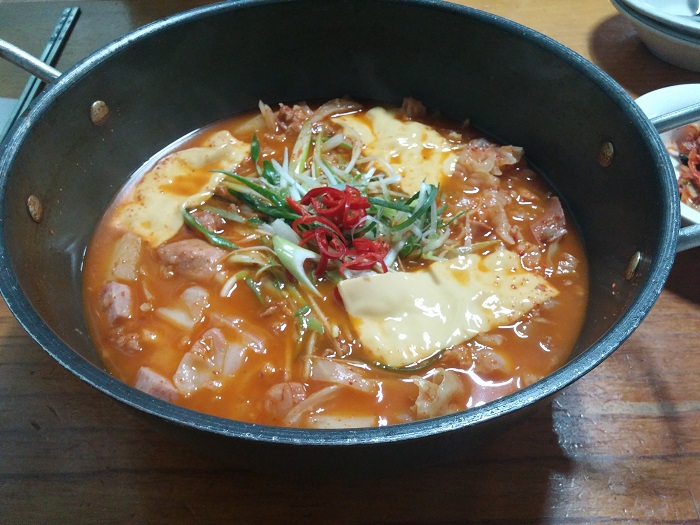
Army base stew, born in the 1950s, takes ingredients from military rations and from indigenous Korean cuisine.
Of course nowadays, just as modern Korean society itself has de-militarized and grown in stature, so, too, has army base stew developed. Today it has a nostalgic warmth and an appeal all of its own. Army base stew today is as far as possible from its war-torn, hungry roots. Today's recipes include bits of ground beef, small meatballs, some hotdog wieners, slices of ham and maybe some bacon bits. Cooks also use slices of processed cheese and packets of instant noodles. Toss it all into a large pan, preferably with a see-through lid. Red pepper flakes (고추가루) or red pepper paste add some kick. Assorted onions, green onions, cabbage or mushrooms can be added, too. A dish born of despair and famine has become a dish of laughter, youth and friendship. Not anywhere near high-cuisine, army base stew is enjoyed at all tiers of society and through all phases of life. Spam and instant noodles are delicious, in their own processed way, and added to red pepper paste and cabbage make for a wondrous dish that could only have been created in the environment endured by modern Korea.
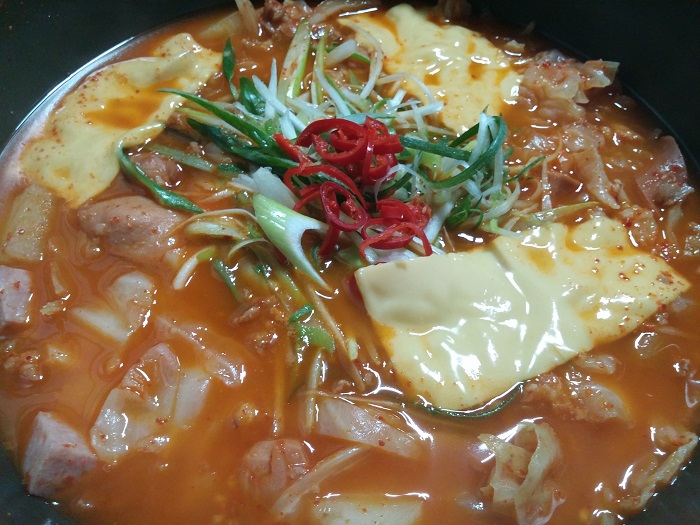
Many cooks add processed cheese and an array of vegetables to their army base stew.
A subset of standard army base stew is called either "Johnson Stew" or "John Stew," depending. Some say the dish is named after U.S. President Lyndon Johnson, in office from 1963 to 1969, who visited Korea during his time in the White House. Others say that the dish got its name because of the stereotype that so many people in the U.S. are named "John." Either way, it's a lighter, less salty version of army base stew and features no instant noodles and no can of baked beans.
There are many places across the capital and the country where one can enjoy army base stew, but "Johnson Stew" is best enjoyed in Seoul's neighborhood of Itaewon. Named after a rest-stop for travelers, this neighborhood is immediately outside the large military base in Yongsan-gu District. Originally just south of city limits, urban sprawl and growth have now overrun the neighborhood and the military base, placing it roughly in the geographic center of today's modern, massive metropolis.
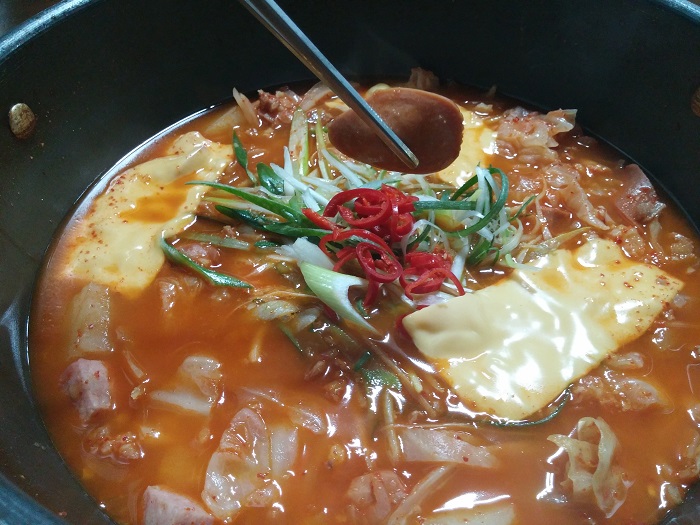
Recipes vary, but hotdog wieners and other processed meats are always a necessity in army base stew.
"Ocean Eatery," or perhaps "Sea Restaurant" (바다 식당), is a hole-in-the-wall diner incongruently located in the glitzier side of Itaewon, surrounded by high-end pizza shops and quite close to the Leeum, Samsung Museum of Art. Ocean Eatery is located at 743-7 Hannam-dong, Yongsan-gu District, Seoul (tel: 02-795-1317). It's a humble place, with only a small sign and no outside advertisements. Inside, there's crowded on-the-floor seating for only about 15 or 20 patrons. The walls of the restaurant are covered with laminated autographs of celebrities who've eaten there. On a Saturday afternoon at 3 p.m., there's already a 30-minute line snaking out the tiny front door. This place's army base stew is some of the best in the capital.
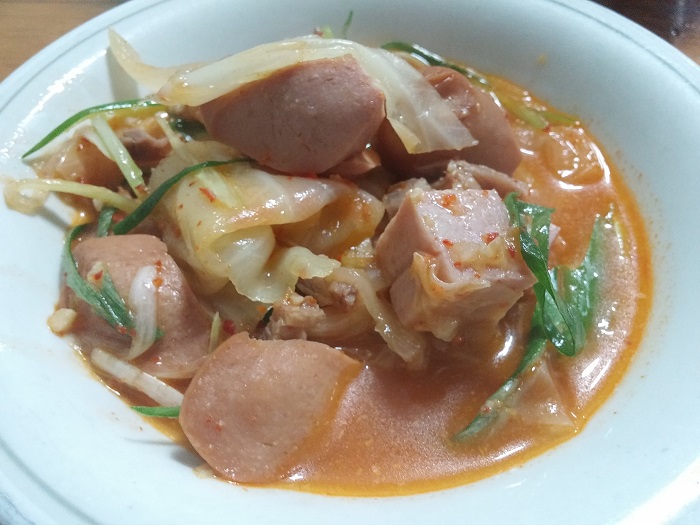
'Johnson Stew' includes hotdog wieners, Spam, ground beef and bacon.
"Johnson Stew" is a lighter, less greasy version of budae jjigae. With no instant noodles and no can of baked beans, diners can enjoy the four different processed meats boiling in the stew: ground beef, sausage, Spam and bacon. The cabbage leaves, onions and peppers add some roughage, and the dish can be ordered in two sizes: medium, for two people, and large, for four people. The restaurant only offers six other items on the menu: pork ribs in barbecue sauce, beef ribs in barbecue sauce, a cast iron plate of wurst, a cast iron plate of turkey sausage, traditional T-bone steak in barbecue sauce and pork chops in barbecue sauce. The place is cheap, humble, delicious and famous, and the dishes are heavy on the meat. Vegans will most likely eat elsewhere.
As you eat your way across Korea, be sure to sample this quintessentially Korean fusion food, a dish that takes bits and pieces from U.S. Army rations and mixes it with indigenous cabbage and peppers, creating a mouth-watering dish entirely unique to this land.
By Gregory C. Eaves
Korea.net Staff Writer
Photos: Gregory C. Eaves
gceaves@korea.kr
Most popular
- First hearing-impaired K-pop act hopes for 'barrier-free world'
- 'Mad Max' director impressed by 'cinema-literate' Korean viewers
- Romanian presidential couple visits national cemetery
- 'Korean mythology is just as wonderful as Greek and Roman'
- Hit drama 'Beef' wins awards from 3 major Hollywood guilds




